OK, here’s all my silly pictures in one go. Or most of them anyway. These were taken all over the United Arab Emirates, though mostly in Dubai. Click the pic for bigger versions.
Tag: dubai
Dubai: The Skyline
I had the good fortune of staying in an apartment rented by a Hungarian skyscraper architect, with a view of the Burj Khalifa. Which, I’m sure you’ve heard, is the world’s tallest building. Tom Cruise climbed up the side of it. (My hostess said a friend worked on that production. They paid more than half a million dollars to take 22 windows off the building while they were shooting.) It is glittery and beautiful, and it lends a distinctly Oz-like element to the city.
Did I take a photo of the view? I did not. Meant to. Completely forgot.
This is what it looked like out the other side of the apartment (my bedroom) when I arrived.
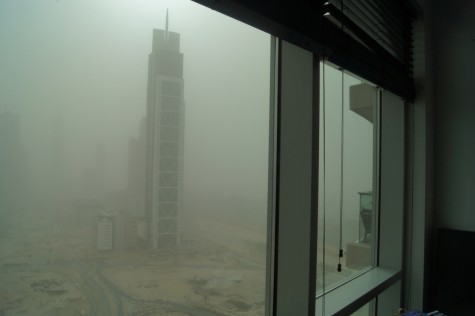
It didn’t clear up for several days, and I drifted around in a sort of apocalyptic fugue state until it did. Ah, here we go:
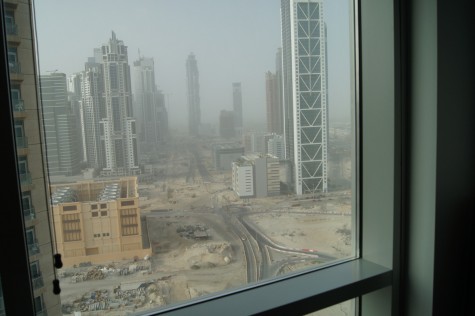
In the lower left part of that picture, you can see some strange silver things that look like cooling towers. My hostess explained that’s a central cooling plant for all the buildings around that area. Fascinating. Air-conditioning is as essential as oxygen here, I think.
I also failed to get a decent photo of Dubai’s other landmark building, the Burj al-Arab. I remember when it was built, and it looked pretty damn dramatic. Now the city has built up a bit, so that it doesn’t look like some weird space pod in the middle of nothing. Very near it is an attractive mall in a faux-old-bazaar style. I’m not even being ironic–it was attractive. It also happens to be built nearly on the site of the oldest Islamic-era settlement in the Emirates. That’s not irony–that’s just destiny, I guess.
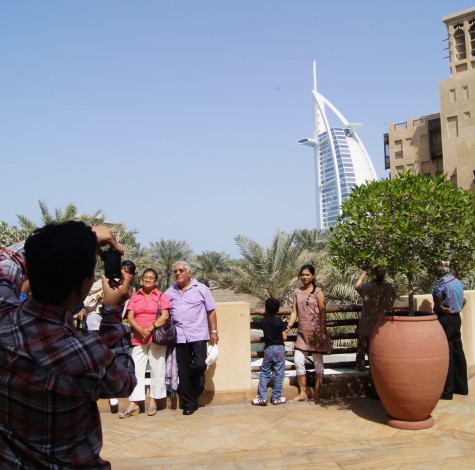
Another huge development is the Dubai Marina. I stayed here the last few days of my trip. It’s even walkable. That is, if you really don’t mind walking, especially across 22 lanes of traffic (there’s an overpass–don’t worry!). My first host, the skyscraper architect, had worked on a building in this area.
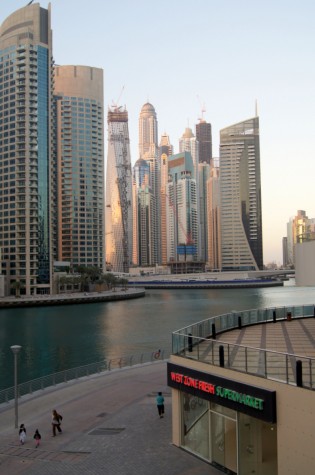
If you’re thinking, Wait–that all looks surprisingly tasteful–I thought Dubai was tacky?…well, yeah. The golden hour does wonders. There are also quite a lot of average-height, average-style buildings. There are a lot of token arches stuck on top of tall buildings, I guess to give them a faux-Islamic look. And then there are these arches, stuck on the top of these tall buildings:
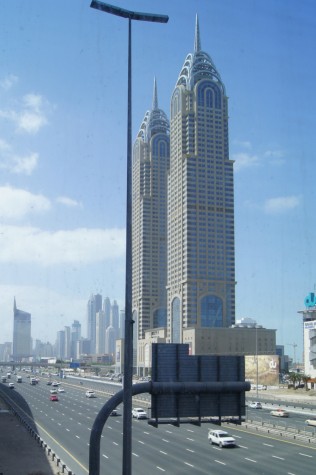
Can the Chrysler Building sue for copyright infringement? And there are two of them because…? Because why not! That’s Dubai in a nutshell.
Anyhoo, because there are people from all over the world designing buildings here, you get some interesting mash-ups. I’m not entirely sure what’s going on with this apartment complex (the lower part, foreground), because those little spires on top are straight out of Asia, but there’s also some kind of Mediterranean vibe:

Dubai, to my surprise when I first went there in 2011, does have a semi-old part of town. You never read about that in the breathless architecture stories. The odd thing about the old-ish parts of any of the Emirati cities is that they’re usually penned in and dubbed a “Heritage Zone” or something like that. The buildings are like zoo animals–the ones that are so depressed they won’t mate, and so will eventually go extinct.
The old fort in Dubai is now a museum. A fairly good museum, in fact, filled with waxworks and assorted dioramas and even taxidermy flamingos. But the sun is setting on all that. Or is that just a shadow cast by all the tall buildings?
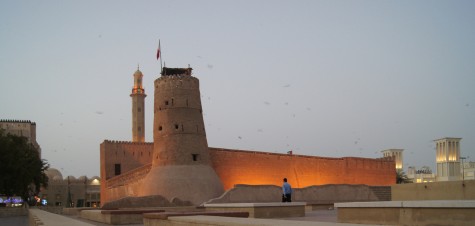
Dubai: Ibn Battuta Mall
Following up the runaway success of my post on Terminal 21 in Bangkok, I think I might become a specialist in theme malls. I admit I felt a little thrill at going to the Ibn Battuta Mall in Dubai not so much because I admire the 14th-century traveler (though I do), but because I was hoping for some really tacky things to take pictures of.
It certainly looked promising. The idea is that the mall’s various sections represent the major places Ibn Battuta traveled: Egypt, India, Persia and China.
Next to the mall is a hotel–that’s the place with the Morocco theme. (Because IB was from Morocco, I guess–so that’s his home base, where he rests his head?)
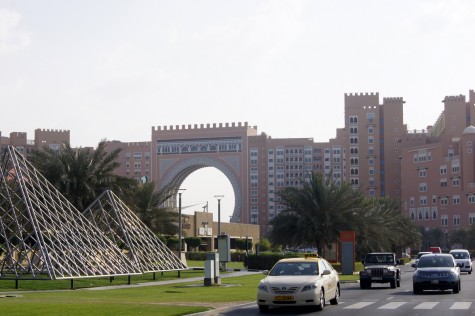
The entrance closest to the metro is the Egypt-theme one. Check it:
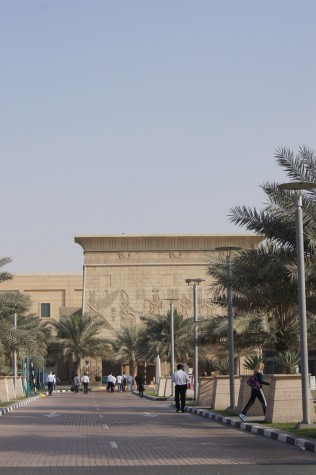
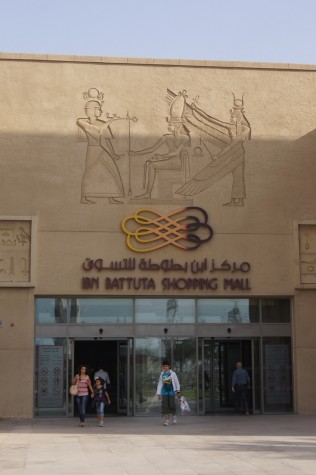
So I’m sauntering in, thinking it’s gonna be super-cheesy…but this is some kind of crazy educational mall. There are all these displays about medieval Arab mathematicians and their assorted genius inventions.
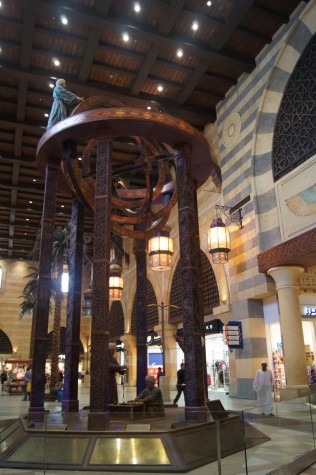
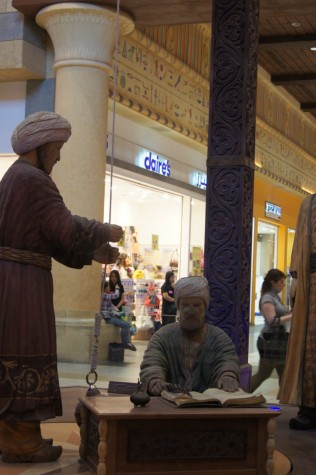
In the Persia court, there was a touchscreen game to play, involving some surprisingly tricky geography and history questions. I got killed by the Black Death before I could make it to the Far East. Story of my life.
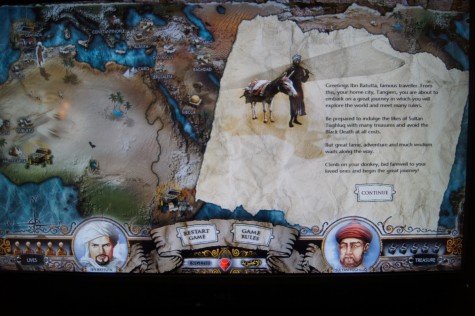
One display even explained properly how all these Arab-invented navigational tools, like astrolabes and quadrants, work. I'm used to just seeing them in dusty museums. Here, you could play with them and line them up with fake stars and things. My actual retention of information is poor, but at the time, I certainly thought, “Wow–I finally get it!”
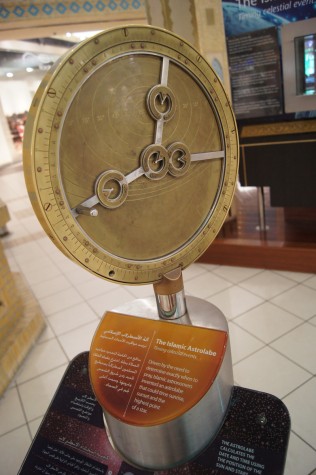
The coolest thing was this, in the India wing. Even though the explanation panels weren’t working, nor was the device itself. Guess what it is?
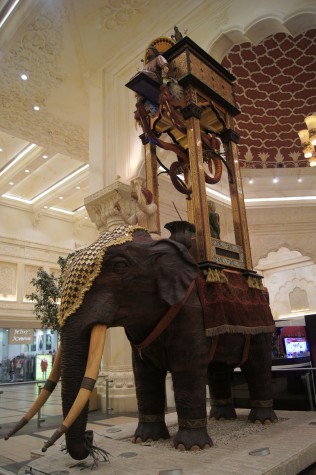
I didn’t know it was a clock at the time–I only read about Al-Jazari’s elephant clock a couple of days later in a museum. But, still. I love that there’s even a bit of grass in the elephant’s trunk. For authenticity.
And the mall is just remarkably beautiful.
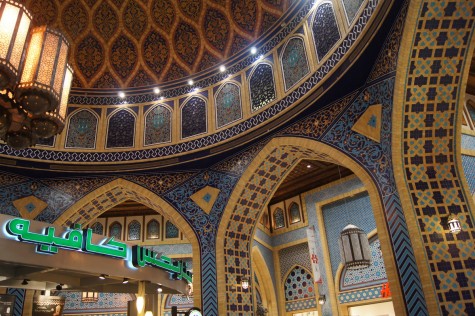
(If that green font is looking kind of familiar…yeah, it’s Starbucks.)
By the time I got to the China wing, I was genuinely agog.
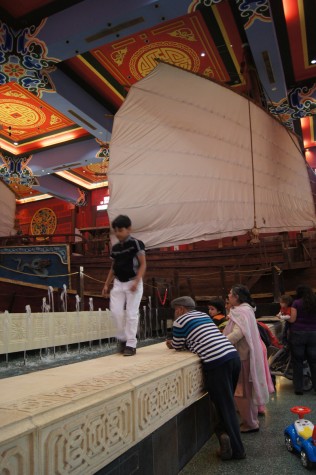
The funny thing is that, despite all this lavish detail, the mall is just not a very good mall. It doesn’t rate a special air-conditioned tube entrance from the metro, so you have to trudge across the pavement in the heat. And if you look back to see how far you’ve come, you see a whole mass of power plants and smokestacks.
It’s all on one floor–no fancy escalators to take in the view from. And the shops aren’t particularly great–in fact, the whole place smells like vinyl from all the cheap shoe stores. (Not complaining–I got some much-needed new sneakers.) There’s a ‘Marble Slab Creamery’ (the much nicer Mall of the Emirates has a real Cold Stone) and other various not-quite-right businesses, like Borders books. Which I thought shouldn’t exist anymore.
And the clientele is a little more downscale. Which means that, instead of tourists in I’m-on-holiday getups and Emirati ladies in rhinestone-studded abayas, there were lots of people in sort of average clothing from wherever they were from. Which was frankly a bit of a relief after all the other Dubai craziness. And, in some cases, it meant they fit in nicely with the decor.
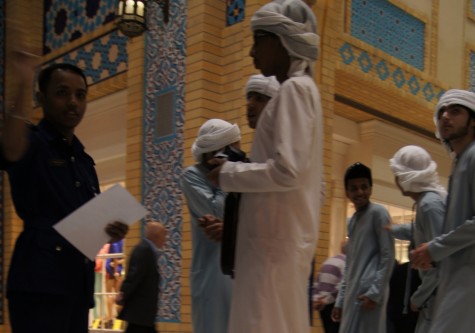
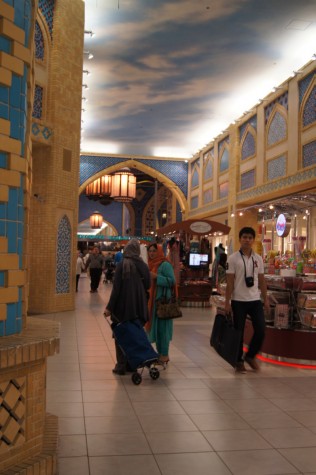
If you’re curious about Ibn Battuta at all (Google did a doodle for his birthday on February 25), do yourself a favor and read Tim Mackintosh-Smith’s books about traveling in his footsteps. The series starts with Travels with a Tangerine, in which TM-S arrives in Dubai and visits this very mall. Hijinks ensue. Truly, it’s great travel writing–hilarious and edifying. You might even be able to buy it at the Borders.
Dubai Is the Future, part 2
[continued from part 1…]
We arrived at the other side of the creek just as the Friday noontime prayer started. Aside from a few tourists milling around, taking pictures of the same penis-shaped minaret as we were…
…the streets were deserted. We took our usual stroll through a supermarket, marveling at the mishmash of Indian, Arab and Asian products on the shelves.
A man steered us away from the Thai fruit juices, pointing to a can of mango juice made in Abu Dhabi and saying, “From here. Fresh!” with pride.
(Wait, was that a real Emirati?! We didn’t stop to marvel like we should have!)
One back corner of the store was fenced off with a chest freezer, blocking the entrance like a fort. Oh, hey—what’s in there?
Oh, I see. Wait, who are those products for?
But…what if a Muslim wants to buy these things?
Ah. No. Got it. Got it.
Finally, we had lunch at a pretty basic Indian joint, which we chose for the special clatter of stainless-steel plates on stainless-steel tabletops, and the intriguing-looking fish dishes. It wasn’t the most amazing food, but it contributed to our sense that the earth’s center of gravity had shifted.
We were in a world oriented around an ocean we knew only from globes, built on thousand-plus-year-old trade routes that were just dashed lines on a map we’d seen on the endpapers of a book. The United States felt like an irrelevant blip.
In the Dubai that is our future, American culture will exist only as a distant reference point—those people who invented the mall, the megaresort and the musical fountain. (And actually, I’m not even sure about the latter two.)
And in the future, apparently there are no women. Dubai is so reliant on guest workers that they make up about 80 percent of the population. Of those workers, the substantial majority are men. Women work in houses. Or, if they’re Emirati, live in houses and can only be seen in the comfortable confines of the luxury wing of the Dubai Mall.
Another unfortunate loss in the future will be subway etiquette. Despite pamphlets with cartoons urging riders to stand aside and wait for people to exit the train car, it was a vicious scrum every time the doors opened. Peter theorizes that multicultural societies have fewer superficial politenesses like this, because no one quite trusts or knows the standards.
I love me a multicultural society, but Dubai trumped New York City for boneheaded subway behavior, and that’s saying a lot.
It looks harmless, but wait till the doors open.
We avoided that unpleasantness once by splurging on a “gold” ticket on the metro, just because we could, and sitting in padded-seat luxury in the front car. There was even an attendant (a woman!) to inspect our tickets and keep out the interlopers.
In the future, as an American I probably won’t be able to afford this privilege–and that may be the most unsettling aspect of all. Maybe I can find work on a dhow…
Dubai Is the Future, part 1
When we use up all our water. When labor becomes completely globalized. When climate change sends temperatures above 120 degrees. When government regulation becomes so hated that zoning rules are chucked. Dubai is what the future will be.
When Dubai was being built up, only about a decade ago, I was totally smitten. It was thrilling to see so many creative buildings and over-the-top plans implemented in one place.
But I only got around to going to Dubai this year, on a stopover to Bangkok. After the whole project started to creep me out a little bit. After I’d read a few exposes about labor practices, and after the gloss of an indoor ski slope wore off, and it just seemed hubristic and wrong.
The first indication that we were in an odd place was in the immigration line, when we realized that the random guys in snow-white robes and starched headdresses walking around were actually officials, as were the guys in robes at the desks. Why they got to walk around in their everyday Emirati clothes, and not in any kind of uniform, only dawned on me later.
Then we marched over to the metro. Or we tried to. We got lost and wound up in a bus bay, and I asked a driver where the metro was. First I tried asking in Arabic, and then realized how dumb that was. The guy was Indian, and told us in perfect English where to get the metro. At the metro, more people told us in perfect English how the system worked. It’s the first time I’ve been in an Arab country where my Arabic was utterly useless.
The next day, we zipped all over the place on the metro—or really, just back and forth, as it’s really only one very long, perfectly straight line. At each stop, I noticed there was always one very bored man in a white robe sloping around.
And then I finally saw a woman make a beeline up to one of these guys and ask him a question. Ohhhhh. The robe was the uniform. That’s how you, if you were a native Dubai-ite, or an Arab of any kind, could know who spoke Arabic. Poor guy had nothing to do in general, but every so often, he had to fend off a cranky person waving a metro card and complaining.
We went to the mall, and saw the same thing. Each info desk was staffed with four polyglot, global-looking people, and one guy in a robe. And the head-to-toe black-clad super-glam shopper-ladies, with their black hijabs piled up high over giant, towering bouffant hairdos (oh, how I love this look!) and their gold trickling down their wrists and their lavish black eyeliner—these ladies knew exactly who to ask for directions to the frozen-yogurt store.
Only once in our admittedly short visit did we ever naturally interact with a native Dubai resident. It was one of those guys on token-Arab duty in the metro, who busted Peter for not having put enough money on our cards.
And why would we have such an interaction? Full Dubai citizens are the upper-upper class, and the rest of the country is filled with guest workers who handle all the tedious stuff, like interacting with tourists. It’s the normal travel situation—in which you meet all kinds of taxi drivers, hotel clerks and tea-sellers, but never your peers—thrown into sharp relief.
Peter and I tried to buck the system. We ignored his brother’s advice not to walk around (“Yes, you don’t want to live there. Don’t fight it. Cabs are cheap.”) and set off on foot from our hotel. The weather was balmy, but podlike air-conditioned bus shelters hinted at a more terrifying climate. We walked along wide boulevards lined with faceless buildings, every window tinted or mirrored to keep out the blazing sun. (“Here’s a cliché for the guidebooks,” Peter snickered. “‘In Dubai, even the buildings are veiled.'”)
We wound up at the docks, lined with dhows. I had just read a lot about them in Tim Mackintosh-Smith’s book Yemen: The Unknown Arabia, and was delighted to see these grand wooden ships in person, looking like they’d just sailed in from the fourteenth century, fresh from a trading jaunt across the Indian Ocean. Now they were getting loaded up with tires, bags of rice and innumerable boxes stamped “Made in China.”
No one spoke Arabic here, either. These men were from Bangladesh. We were the most interesting thing they’d seen all day.
So were my breasts, apparently. Cheek-squeezing devolved into a clumsy boob-grab. (If only boob-grabbers knew what they were doing! But by definition, a boob-grabber has no experience with boobs. Getting fondled on the street used to make me feel preyed upon and victimized; now it just makes me feel sorry for the dudes.)
We hopped a boat across the “creek,” the little river that flows through the oldest part of Dubai. We meant to take an old-fashioned one, where you’re hanging inches above the water and holding yourself up as if you’re a straphanger on the subway. But instead we wound up on a proper posh city-run boat.
(to be continued…)










